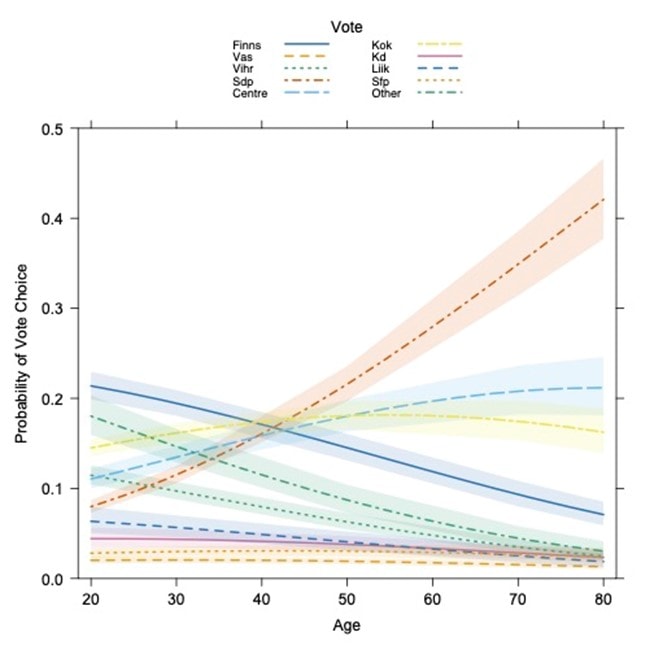The narrative that Finns Party support is substantial among young people is misleading. Age plays only a limited role in determining support for the party. The real puzzle is the substantial age gap in support for the Social Democrats.
A recent theme in western media involves the casting of younger generations negatively in contrast to older generations using clickbait news titles and surface level discussions. News headlines conveying that younger generations are having a hard time ‘adulting’, or that younger people simply like living at home, have become commonplace to the point of being parodied.
These stories often lack the nuance or detail that goes beyond simplistic narratives to accurately explain the behavior or views of younger individuals. News stories about the relationship between younger people and politics is equally susceptible to simplistic generalizations about their behavior. In Finland, this phenomenon has recently manifested itself in narratives about young people’s greater support for one of the country’s far right parties – the Finns party.
Finnish media, younger people, and Finns party support
The Finnish media has published several news stories highlighting a link between younger people and support for the Finns party. For example, a recent press release from a research organization highlighted by the media indicates that TikTok impacts the voting behavior of younger people, and that the effect is especially strong for voting for the Finns Party. Yle News published a related story where they indicated that one-third of young people who use TikTok would vote for the Finns party.
The article was mostly framed around how the Finns party has been able to attract youth support through the app. The article dedicated considerable attention to the strategies of the party’s posts. The narrative is that younger people on the platform are particularly receptive to the types of content that the Finns party disseminates. The story did not ask the obvious question – is it that the Finns party is using TikTok to attract young voters’ support or that the party has created a ‘meeting place’ for the young supporters they already acquired?
The story leaves us to posit why Finns party support is so strong among younger voters and whether TikTok is the cause? What these stories lack are nuanced explanations and systematic comparisons to other age groups and the support of competitor parties.
A more nuanced analysis of the relationship between TikTok and Finns party support was published in Helsingin Sanomat. This story highlighted that the Finns party is the most popular party among the youth, which has been discussed in additional news stories. However, the story pointed out that according to a recent study younger voters do not support the policies of the party. The story leaves us to posit why Finns party support is so strong among younger voters and whether TikTok is the cause? What these stories lack are nuanced explanations and systematic comparisons to other age groups and the support of competitor parties.
Additionally, the news has recently emphasized the results from the democracy education event (Nuorten vaalit). The “the youth elections” event is used as an educational tool where youth participants under the age of 18 vote for a candidate running in the Finnish presidential election. The result of the event was that Finns party candidate Jussi Halla-aho finished second in the voting and missed first place by just over 600 votes (out of 94,000 cast). The result has led some to ponder over whether the Finns party is especially attractive to young people.
What does the democracy education event results tell us?
The democracy education event results convey only some information to researchers. However, that information is unlikely to be the attractiveness of the Finns party to younger people. Instead, the results more likely indicate quite a bit about some of these younger peoples’ families.
Since the 1960s political scientists have uncovered that the family is one of the strongest ‘agents of socialization’ in democracies. Agents of socialization are those entities that impact an individual’s political attitudes through the socialization process, which includes family, social groups, school, religion, etc. Studies confirm that there is a strong connection between parental partisanship/vote choice and that of their children. The relationship is especially strong when individuals are younger.
A study in Finland by Gidengil, Wass, and Valaste in 2016 showed that the likelihood a young person even votes can be directly tied to their parents’ political behavior. The results from the democracy education event are more likely reflective of parental attitudes rather than an informed selection of a candidate based on their own ideological commitments. As the Helsingin Sanomat article mentioned above highlighted, there is an incongruence between younger Finns party supporters’ policy preferences and those of the party.
Since the 1960s political scientists have uncovered that the family is one of the strongest ‘agents of socialization’ in democracies. Agents of socialization are those entities that impact an individual’s political attitudes through the socialization process.
Alternatively, the democracy education event might convey little to no information about younger people. First, the participants are casting a vote in an event that has no real-world stakes. The purpose of the event is that it is an educational tool. There are no consequences for their vote choice, which is not the case for actual voters. Therefore, the incentive to be an informed participant is missing from the activity.
Second, and related, as previous participants are aware, the seriousness that individuals approach this type of event does not match that of a real election. There is always a handful of participants that cast their votes in a joking manner. Finally, the younger participants lack a cohesive ideological profile. It takes time to develop an individual’s comprehensive set of political orientations towards society. Therefore, the choices might not be based on policy preferences, but rather other non-political considerations such as a candidate’s appearance or media reporting.
Analysis shows the relationship is over-emphasized
To calculate the precise impact of age on vote choice, I conducted an analysis from a survey of around 3,000 Finnish respondents just prior to the parliamentary election. My analysis controls for a range of demographic variables, as well as attitudinal positions (views on the economy, environmental issues, LGBTQI+ rights, and immigration). When I plot the impact of age on vote choice in the figure, we see that age only has a small impact on vote choice for the Finns party.

Figure: The impact of age on vote choice
The first aspect of the figure to notice is that the probability of vote choice is never greater than 25 percent for any party for younger people. In fact, the difference in the probability of voting for the parties that came first through fifth in the 2023 parliamentary election is on average only a four percentage point difference for 20 year old respondents. The result indicates a lot of fragmentation in the youth vote – no dominant party among the youth.
The result is not surprising given that younger people have not developed partisan attachments. Again, the lack of partisanship is due to an unformed ideological profile. In addition, youth voters are not a monolithic group that has a dominant issue to rally around, such as older voters and an issue like pensions. Thus, we would expect the youth vote to be divided between several parties as these young people navigate through the early years of political socialization.
Youth voters are not a monolithic group that has a dominant issue to rally around, such as older voters and an issue like pensions.
Comparing younger people to older people, the figure points to only small age related differences in vote choice for the Finns party. An individual that is 20 years old is only on average 3.8 percent more likely to report vote choice for the Finns party when compared to a 50 year old. When comparing a 20-year-old to an 80-year-old the difference is around 10 percent. The differences are small but could still be meaningful. Does this mean the Finns party is more attractive to younger people? Not necessarily, in fact, the results point to another narrative.
The narrative does not involve the Finns party’s oversized attraction to younger people, but instead the extremely large amount of support for the Social Democrats among older people. The results show that the probability of vote choice for the Social Democratic Party increases drastically with age. An individual that is between 70–80 years old is between 35–40 percent more likely to vote for the Social Democrats when compared to a 20-year-old voter.
The small age-related gaps in Finns party vote are likely a product of older voters’ very strong attachment to the Social Democratic Party. The finding aligns with narratives that older people have a much stronger partisan attachment to the Social Democrats in the Nordic countries. The question the media should be asking is why are the Social Democrats failing to appeal to young people? Therefore, the real puzzle is explaining gaps in Social Democratic party appeal.
Media and a bandwagon effect: A warning
Several studies show a bandwagon effect related to elections where citizens cast a vote for a candidate that they perceive, through the publishing of favorable news stories or opinion polls, as popular. The people that are most susceptible to this type of bandwagon effect are individuals that are low information voters or pay less attention to politics, which tends to be younger voters.
Given the disproportionate amount of attention the link between younger voters and Finns party support has received in the media, there is the potential that the relationship becomes a self-fulfilling prophecy. In other words, younger votes may express support for the Finns Party in the future because they believe their peers also support the party due to the media’s incomplete reporting.
Therefore, the perpetuation of the narrative that the Finns party has an oversized appeal among young people could have implications for actual election results. That outcome would be unfortunate because the reality is that there is no party that dominates support from younger people in Finland. Instead, it is the case that younger people are dividing their support among several parties. We could call this process “finding a partisan home.” In addition, there is not a large difference between younger and older people in support for the Finns party. In all, news stories attributing Finns party success to younger people are not providing a complete picture.
Ph.D. Michael A. Hansen is an Associate Professor of Political Science at the University of Turku.
Article image: Elizeu Dias / Unsplash
Article updated 30.1.2024 at 15.05: Some minor typos corrected.






Pingback: Europe’s Youth Are Fueling the Far Right